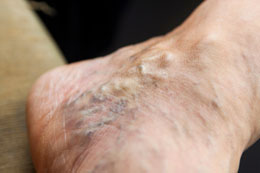The causes of lower leg swelling can vary from insect bites to medical conditions like blood clots, varicose veins, and edema.

Lower leg swelling is a condition that can bring day-to-day activities, like walking, to a standstill. This is because, in most cases, the swelling is painful and standing even for a short time may seem difficult. Bilateral swelling of the lower limbs is a serious issue and needs to be addressed immediately as it has been associated with heart problems, liver and kidney disorders.
Causes
Injury
Swelling is the most common side effect of an injury. Sports injuries such as sprained ankle, can make the lower leg swollen. A trauma such as an accident or a blunt object hitting the leg, can cause severe injury and result in swelling of the legs.
Edema
Edema is a condition that causes abnormal fluid build up in any part of the body. However, edema problems are generally observed in the feet. Dehydration, too much salt in the diet, and lack of physical activity are some of the most common causes of edema, in which the body tries to retain water. This leads to buildup of fluids in the body cells, causing the lower leg to swell.
Insect Bite
An insect bite on the leg can also trigger swelling in the lower part of the leg. When a wasp or a bee stings, it is normal to experience pain, redness, and swelling in the affected part of the skin. However, those who have a sensitive skin or are allergic to insect bites, are bound to suffer from severe side effects in which the swelling does not remain restricted to the area of bite and often spreads to the lower leg.
Blood Clots
Blood circulation problems in the veins that run through the calf and leg muscles may also cause swelling. This can occur when an unexpected blood clot forms in the veins, which can cause fluid to accumulate in the surrounding tissues. Medical conditions such as deep vein thrombosis that usually affect the leg can cause swelling.
Varicose Vein Problem
These are the veins that just lie below the skin. The problems occur when these veins widen due to excessive pressure, which causes a rupture of the valve system in the vein. This disrupts normal blood circulation in the lower leg and is accompanied by buildup of blood and fluid in the veins. Pain and lower leg swelling is the most common symptom of varicose vein. Studies show that overweight people are prone to this condition.
Treatment totally depends upon the underlying cause. For instance, for an injury or an insect bite, rubbing ice cubes gently on the affected part can help to reduce the swelling and the associated pain. Anti-inflammatory medications for injuries, such as ibuprofen as well as resting the leg in an elevated position is also beneficial to decrease the swelling.
Disclaimer: The information provided in this article is solely for educating the reader. It is not intended to be a substitute for the advice of a medical expert.


 Lower leg swelling is a condition that can bring day-to-day activities, like walking, to a standstill. This is because, in most cases, the swelling is painful and standing even for a short time may seem difficult. Bilateral swelling of the lower limbs is a serious issue and needs to be addressed immediately as it has been associated with heart problems, liver and kidney disorders.
Lower leg swelling is a condition that can bring day-to-day activities, like walking, to a standstill. This is because, in most cases, the swelling is painful and standing even for a short time may seem difficult. Bilateral swelling of the lower limbs is a serious issue and needs to be addressed immediately as it has been associated with heart problems, liver and kidney disorders.